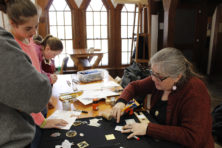Gibraltar School Moves Away from Mixed-Age Classroom Options
- Share
- Tweet
- Pin
- Share

Gibraltar Area School is pulling away from having multi-age classrooms – an option the district provided to families starting in 2014.
For a decade now, Gibraltar Area School has had traditional, self-contained, single-grade classrooms and some multi-age classrooms with second and third grades and even fourth and fifth grades with multiple teachers.
While the district still will give parents the option of placing their kindergarteners and first-graders in a multi-age classroom with co-teachers, the school board this month voted to discontinue the multi-age classrooms for older students.
The board followed the recommendation of principal Lauren Ward and the board’s Student Learning Committee to eliminate the option of placement in mixed-grade classrooms for second, third or fourth grades next year.
Curriculum has been restructured in such a way that the students in the multi-age classrooms were not learning the same way as students in the single-grade classrooms.
Ward told the board the students risked missing content that they needed to learn. By third grade, students are no longer learning to read, but rather they are reading to learn, Ward said.
She said this move away from multi-age classrooms is no reflection on the skill or efforts of the teachers. Superintendent Brett Stousland said the change will not result in job cuts.
Some students who were in multi-age classrooms got to sixth grade and did not know their classmates, and third-graders and fourth-graders and their teachers tended to move students to different sides of the room based on grade-level, the school board was told this month.
None of the current board members were serving when the board approved the multi-age classrooms. Don Helm, the longest-serving board member, said the multi-age classrooms were a passion for former Superintendent Tina Van Meer.
Van Meer told the Peninsula Pulse in 2019 – about five years after the concept was put in place – that the multi-age classroom enabled a students’ natural development. The structure was less likely to harm a child’s self-esteem if they were not grasping concepts within a given timeframe, she said, while also allowing more advanced students to make better progress while learning with older classmates.
Stousland said multi-age scenarios more traditionally develop when a school doesn’t have enough students in two back-to-back grades and they assign one teacher for all the students in two grades – for example, eight third-graders and seven fourth-graders would turn into one multi-age room.



